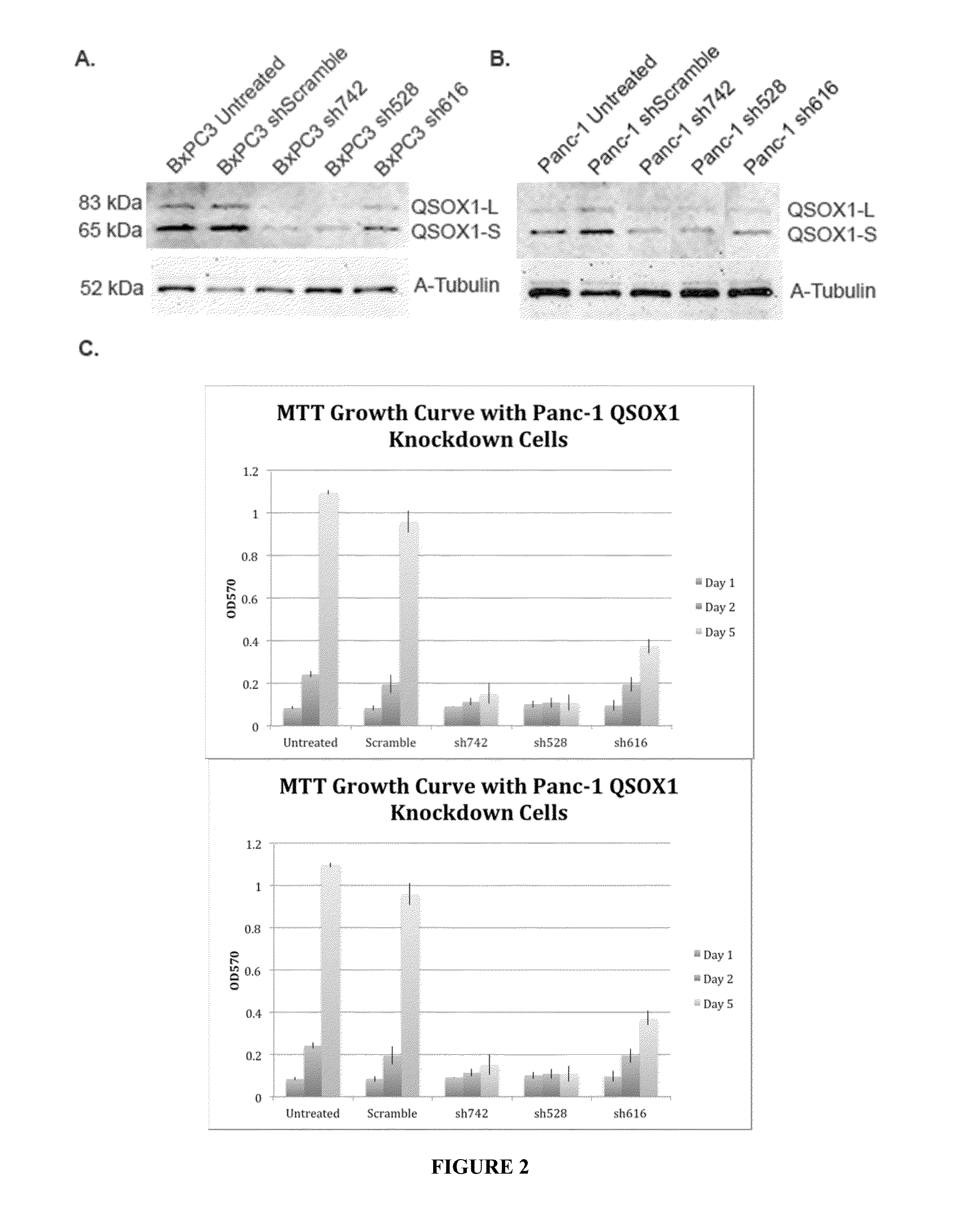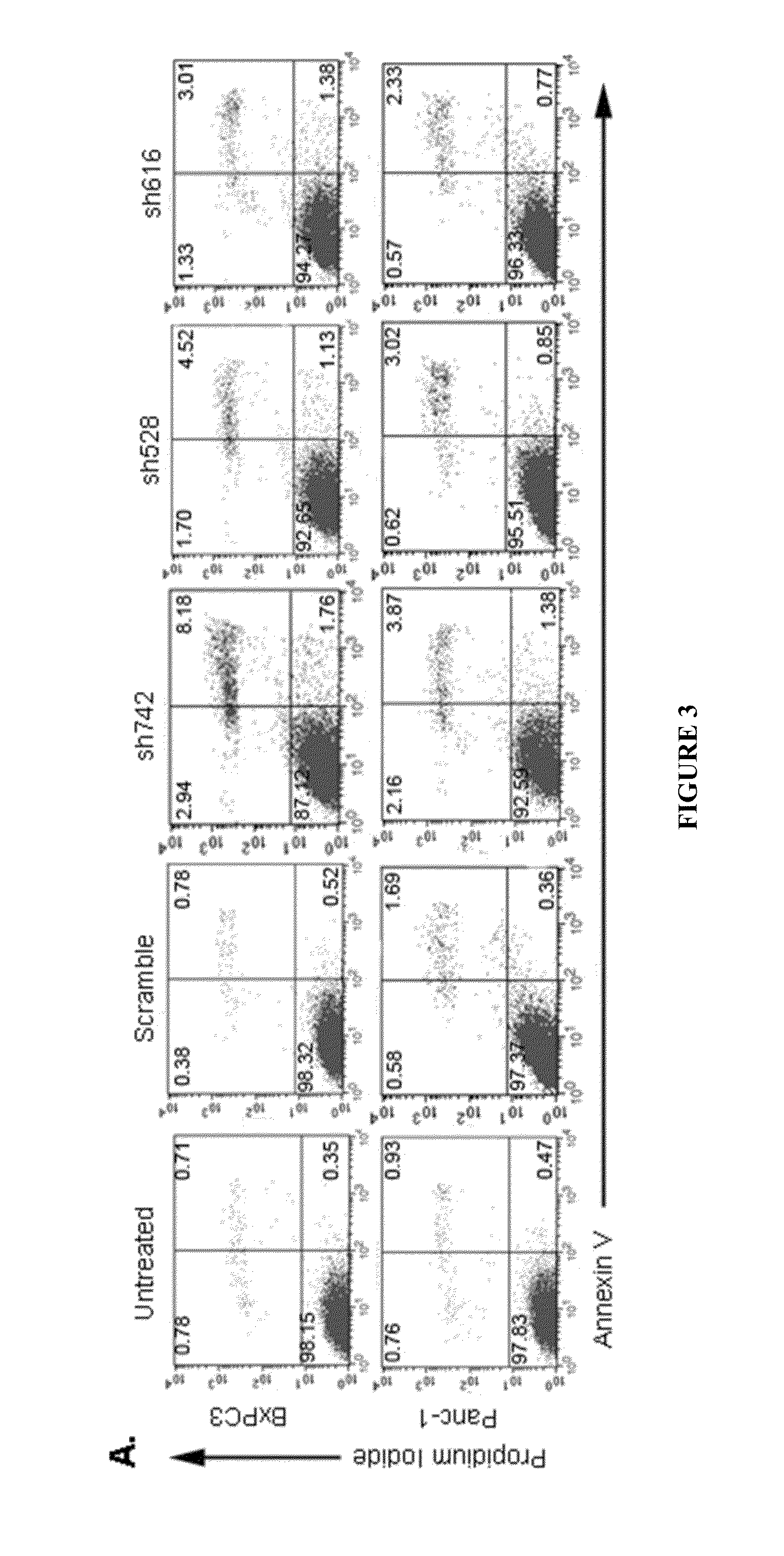QSOX1 as an Anti-Neoplastic Drug Target
a technology of antineoplastic drugs and qsox1, which is applied in the field of qsox1 as an antineoplastic drug target, can solve problems such as unresectable tumors, and achieve the effect of limiting tumor metastasis
- Summary
- Abstract
- Description
- Claims
- Application Information
AI Technical Summary
Benefits of technology
Problems solved by technology
Method used
Image
Examples
example 1
REFERENCES FOR EXAMPLE 1
[0146]1. Bardeesy N, DePinho R A. Pancreatic cancer biology and genetics. Nature Publishing Group 2002; 12:897-909.[0147]2. Koshiba T, Hosotani R, Wada M, Miyamoto Y, Fujimoto K, Lee J U, et al. Involvement of matrix metalloproteinase-2 activity in invasion and metastasis of pancreatic carcinoma. Cancer; 1998. p. 642-50.[0148]3. Strimpakos A, Saif M W, Syrigos K N. Pancreatic cancer: from molecular pathogenesis to targeted therapy. Cancer Metastasis Rev 2008; 3:495-522.[0149]4. Antwi K, Hostetter G, Demeure M J, Katchman B A, Decker G A, Ruiz Y, et al. Analysis of the plasma peptidome from pancreas cancer patients connects a peptide in plasma to overexpression of the parent protein in tumors. J Proteome Res 2009; 10:4722-31.[0150]5. Coppock D L, Cina-Poppe D, Gilleran S. The quiescin Q6 gene (QSCN6) is a fusion of two ancient gene families: thioredoxin and ERV1. Genomics 1998; 3:460-8.[0151]6. Coppock D. Regulation of the Quiescence-Induced Genes: Quiescin Q6...
example 2
[0179]We designed two short hairpin RNAs (shRNA1 and shRHA2) to knock-down QSOX1 protein expression in tumor cells.
[0180]shRNA1—Targeting QSOX1 sequence begins at the 970th base pair—
(SEQ ID NO: 17)ATCTACATGGCTGACCTGGAA
[0181]shRNA2—Targeting QSOX1 sequence begins at the 1207th base pair—
(SEQ ID NO: 18)AGGAAAGAGGGTGCCGTTCTT
[0182]QSOX1 shRNA1 hybridizes with nucleotides 970-989 of the QSOX1 transcript. QSOX1 shRNA2 hybridizes to nucleotides 1207-1226 of the transcript. Both shRNAs, independently and together suppressed the production of QSOX1 protein (data not shown) and cell proliferation. Upon cloning the QSOX1 shRNA into a eukaryotic expression vector (pCS2 mammalian overexpression vector with a CMV promoter) and using it to transfect a pancreatic tumor cell line (BxPC-3), a 30-40% decrease in cell viability was observed, over a 4 to 6 day period, compared to untreated and scrambled shRNA controls. (FIG. 6) Using the same transfection protocol in a separate experiment, we made an...
example 3
[0185]MIAPaCa2 and Panc-1 pancreatic tumor cells were transduced with shRNA that specifically knocked down QSOX1 protein in the tumor cells. The shRNAs used to knockdown QSOX1 in tumor cells were
QSOX1 sh742(5′-CCGGGCCAATGTGGTGAGAAAGTTTCTCGAGAAACTTTCTCACCACATTGGCTTTTTG-3′ (SEQ ID NO: 26))
and shRNA QSOX1 sh528
(sense) (SEQ ID NO: 21)5′-CCGGACAATGAAGAAGCCTTT-3′,
Nude mice Human pancreatic tumor cells (MIAPaCa2) were transduced with a lentivirus encoding shQSOX1 (sh528 and sh742) and shScramble (control). One million MIAPaCa2 cells were mixed with Matrigel™ and used to inoculate nude mice (5 mice / group) on day 0. After day 12, tumor growth was measured every 3 days (x-axis) and reported as “Tumor volume” on the Y-axis. “Untreated” indicates that tumor cells were not transduced. (see FIGS. 8 and 9). This in vivo experiment thus validates QSOX1 as a potential target for anti-neoplastic drugs. Any other type of inhibitor of QSOX1 expression or function would have a similar effect on tumor ce...
PUM
| Property | Measurement | Unit |
|---|---|---|
| pore size | aaaaa | aaaaa |
| pH | aaaaa | aaaaa |
| voltage | aaaaa | aaaaa |
Abstract
Description
Claims
Application Information
 Login to View More
Login to View More - R&D
- Intellectual Property
- Life Sciences
- Materials
- Tech Scout
- Unparalleled Data Quality
- Higher Quality Content
- 60% Fewer Hallucinations
Browse by: Latest US Patents, China's latest patents, Technical Efficacy Thesaurus, Application Domain, Technology Topic, Popular Technical Reports.
© 2025 PatSnap. All rights reserved.Legal|Privacy policy|Modern Slavery Act Transparency Statement|Sitemap|About US| Contact US: help@patsnap.com



